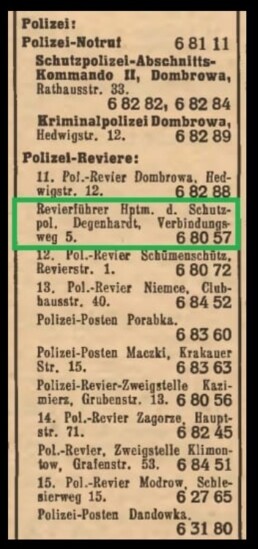Hauptmann Paul Degenhardt
"The Lord of Life and Death" in Częstochowa
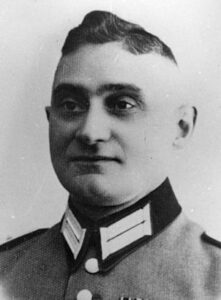
In the spring of 1942, Hauptmann Paul Degenhardt was transferred from Sosnowiec to Częstochowa, where he took command of the Schutzpolizei – the uniformed German Police Force. He remained in that position until the end of 1943, when he was transferred to the staff of the commander of the Ordungspolizei, in Corinth Greece, to combat local partisans.
The police department in Częstochowa, which Degenhardt took over, initially comprised 30-40 German officers. It was reinforced to 50-60 men by the summer of 1942. Over time, the name of this command was changed to the Schutzpolizeikommando (“Protection Police Command”). Its area of responsibility corresponded to that of a comparable agency within the Reich.
During his time in Częstochowa, he oversaw the “resettlements”, from 22nd September until mid October 1942, during which over 40,000 Jews were transported, by train, to their deaths at the Treblinka extermination camp.
During each selection for “resettlement”, with his riding crop in hand, Degenhardt would indicate to the left or the right – left meant death, right meant “able to work” and a little longer to live.
Degenhardt also oversaw the liquidation of the “Big Ghetto” and the creation of the “Small Ghetto”. He then also oversaw the liquidation of the “Small Ghetto” and the transfer of remaining survivors into barracks of the slave labour camps.
During that time, he also committed, or ordered to be committed, the murders of individual Jews, for which he stood trial in the Lüneburg District Court (Germany), beginning on 29th December 1965. On 25th May 1966, he was found guilty of twenty-eight charges of murder (involving seventy-one victims) and was sentenced to life imprisonment.
He served seven years in prison and was released on health grounds. He died not long afterwards.
CLICK ON EACH HEADING BELOW TO VIEW DETAILS
Paul Degenhardt, was born, on 5th January 1895, in Landeshut/Schlesien, into a large family of roofers. He and his five siblings were mainly raised by their mother (Anna nee Wit), as their father died in as work accident at the turn of the century.
He attended elementary school and then began work in a silk weaving plant where, through self-study, he became a pattern draughtsman.
In August 1914, he volunteered as a soldier. During the First World War, he was deployed on the Eastern Front and was twice slightly wounded by grazing shots. Following the end of the war, he joined the Freikorps, fighting in the east.
In November 1919, he joined the Sicherheitspolizei [Security Police] in Breslau. In 1920, after attending a police academy, he came to Oels and, after having worked in various commandos in Kreuzberg and Gleiwitz and taking part in other courses, he became a police sergeant in 1927.
On 23rd February 1931, in Gleiwitz, he married Charlotte Arn. They had three adult daughters came from this marriage. A son died soon after birth.
On 1st September 1932, Degenhardt became a member of the National Socialist Party – Membership No.: 1,330,601.
In the following years, he became actively involved in the party. In 1932-1934, he also belonged to the S.A. In 1938, as police chief, when he took over the local police station in Ackerfelde, he also became that town”s local NSDAP group leader.
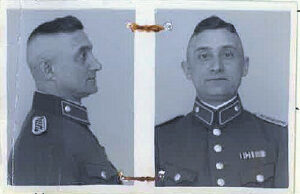 Ref: R 70 POLEN – 908
Ref: R 70 POLEN – 908
It is believed that this is Degenhardt’s civil service personnel file and that he appears in a policeman’s uniform..
It shows that he was married on 25th February 1931 and subsequently had four children, one of whom died after one day.
More details are shown in the English-language translation of this document.
On 1st June 1940, Degenhardt joined the general SS and, having been promoted to lieutenant in the Security Police, he immediately received the rank of SS-Untersturmführer. Around this time, for official reasons, he needed to change his place residence several times.
At the end of 1941 or the beginning of 1942, on 19th January 1941, he became an SS-Obersturmführer and, at about the same time, he was promoted to SS-Hauptsturmführer.
In the spring of 1942, Degenhardt was moved from Sosnowiec to Częstochowa, where he commanded the local police – taking over from Hauptmann Heutz, who was not a member of the SS. He remained in command there until the autumn of 1943.
During that time, he oversaw the deportation of over 40,000 Jews from Częstochowa to the Treblinka death camp. He also oversaw the creation and the liquidation of the Częstochowa “Small Ghetto”.
While in Częstochowa, he committed, or ordered to be committed, numerous murders. which are described in detail in the court verdict (the transcript of which appears on this page in both the original German and the English translation). In 1966, he was convicted on twenty-eight charges of murdering seventy-one Jews.
After leaving Częstochowa, Degenhardt returned to Sosnowiec for a short time – to the police headquarters, which had been established there in the meantime.
At the end of 1943, he was then transferred to the staff of the commander of the Ordnungspolizei in Corinth. One of his responsibilities there was to fight partisans.
When the Front was receding, he returned, via Vienna, to what was then Reich territory and ended up in northern Germany.
In April 1945, on the Elbe, he was taken prisoner-of-war by the Soviets – but he was soon able to escape. Shortly after, near Ludwigslust, Degenhardt was picked up by English troops, but escaped again
With “any” papers which he had been able to get hold of along the way, he went to Leipzig, where his brother-in-law gave him civilian clothes. He then made his way to Silesia [Pol: Śląsk], where he was arrested by Polish militiamen and was imprisoned in Ratibor [Pol: Racibórz].
After fleeing again, he took a job with a farmer in Thuringia, but then moved west, when American troops evacuated Thuringia. In Regensburg, he had papers issued in the name of his father-in-law and, as a construction worker, worked there and in the surrounding area. He then joined a refugee transport heading to Upper Bavaria and, still under a false name, worked as a farm hand until 1950.
Around this time, he found out that there was a police officer, living in Celle, who knew him from previous joint official activities before the war. Degenhardt went to see him – it was Hauptkommissar [Chief Inspector] Galonska. He told him that he had recently been released from Polish captivity. After Galonska confirmed his identity, he had the correct papers issued again. He remained in Celle, working in various jobs. From Celle, he again got in touch with his family, who had found shelter in the Ore Mountains.
Together with them, in 1951, he moved into an apartment in Unterlüss.
At the end of 1951, for the first time, Degenhardt showed signs of a mental disorder. He was admitted to the Lower Saxony State Hospital in Lüneburg by decision, on 18th November 1955, of the Celle District Court .
The medical officer’s report, dated 17th November 1955, contained the diagnosis that he was suffering from increasing mental and physical restlessness, which had increased to nocturnal “wanderlust” and that, according to his own statements, he was hearing voices that he had heard from his earlier experiences in fighting against partisans.
In addition, the medical officer had found an injury on Degenhardt, the result from an attempted suicide.
However, a final decision on his accommodation was not made, as Degenhardt agreed to remain in the hospital voluntarily. The “final improvement”, when he was released on 7th January 1956, did not last. On the advice of his family doctor, he returned to the Lüneburg State Hospital.
From there, on 7th July 1956, he was released as largely improved.
[Webmaster: There are opinions that Degenhardt was feigning illness in order to avoid prosecution.]
Almost three years later, namely on 11th May 1959, for a third time, Degenhardt entered the Lüneburg State Hospital for treatment of an “endogenous psychosis”.
It was here, on 14th December 1959, that an arrest warrant, dated 9th December 1959, was executed.
He was suspected of being an accessory to murder. Pre-trial detention was ordered to be carried out in the State Hospital because of Degenhardt’s state of health.
Another arrest warrant was issued, on 23rd October 1963, by an investigating judge of the Lüneburg District Court and was executed on Degenhardt on that day.
It was based on the suspicion of murder. It is believed that the delay, some four years, in issuing this warrant was due to the prosecution attempting to locate appropriate witnesses to the different charges.
The pre-trial detention was carried out on the basis of that warrant, after the first warrant was overturned by decision of the First Serious Crime Division of the Lüneburg District Court on 12th March 1965
According to the Lüneburg Public Prosecutor, after serving seven years in prison, due to his ailing health, Paul Degenhardt was freed by the Niedersachsen Minister-President – as an “act of mercy”.
[Webmaster: Ironic, since he showed no mercy towards his Jewish victims.]
On 24th May 1996, Degenhardt was sentenced to life imprisonment by the Lüneburger Schwurgericht (court) and was serving his sentence in the Strafvollzugsanstalt Celle [prison in Celle]. His health was already weak at the time of the trial.
He died not long after his release.
Acknowledgements:
The World Society
sincerely thanks
DR. ROMAN RADWAŃSKI
and
PROFESSOR JERZY MIZGALSKI
for their efforts in discovering this material and arranging to make it available for our website.
COPYRIGHT NOTICE:
Copyright of the original material contained on this page belongs to
BUNDESARCHIV in BERLIN
(German National Archive)
and
INSTYTUT PAMIĘCI NARODOWEJ (Institute of National Remembrance)
Copyright of the English language translations belongs to
ANDREW RAJCHER.
The material, on this page,
may NOT, either in part or as a whole, be copied, distributed or published without the prior written consent
of the copyright-holders.

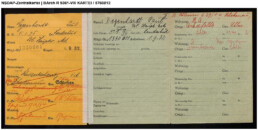
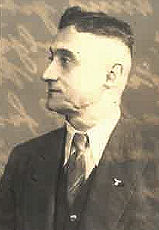 Ref: R 9361 IIII – 29324
Ref: R 9361 IIII – 29324